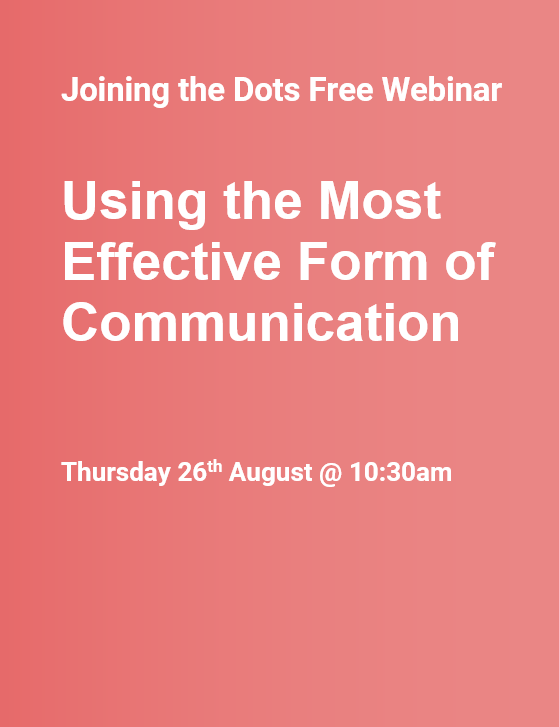Wednesday 11 Aug 2021 Article
The TakeawayMehrabian’s Communication Theory: The 7 38 55 Rule
Mastering Effective Communication
Part 1 of 3
#FreeWebinar #EffectiveCommunication #MehrabiansTheory
The perfectly matched resource for this article...
[Free Webinar] Using the Most Effective Form of Communication
This webinar will help you understand what communication is, identify the barriers to effective communication, and show you how to choose the most effective and appropriate way to communicate based on the situation.
Sign up for free!Playing catchup?
Mehrabian’s Communication Theory: The 7 38 55 Rule
Being able to effectively communicate with clients, customers, and colleagues is vital to the success of organisations. Without communication, sales can’t be made, meetings can’t be organised, and generally - businesses cannot run.
However, being able to communicate effectively is often easier said than done. We often put too much emphasis on what we say, rather than how we say it, even though many studies, including Mehrabian’s Communication Theory, suggest that vocal and visual communication are also vital.
What Is Mehrabian’s Communication Theory?
In the 1970’s, Professor Albert Mehrabian pioneered our understanding of communications when he created the Mehrabian Model/Theory.
His research and studies suggested that people deduce impressions and make judgements heavily based on the speaker’s body language and tone of voice, rather than what they are actually saying. The model quantifies the impact of different types of communication, known as the 7 38 55 Rule:
- 7% verbal communication (the actual words that are spoken)
- 38% vocal communication (the way the words are said)
- 55% visual communication (what we do with our face and body while speaking)
It is said that many centuries ago, the first humans had undeveloped voices making them heavily dependent on non-verbal communication, which is why non-verbal communication is engrained in the way we think and is still such a key part of the way we communicate to this day.
Whilst there are some controversies about how accurate Mehrabian’s statistics are, it is clear that tone and facial expressions do influence how we perceive what is being said.
How To Use the 7 38 55 Rule
To implement the 7 38 55 Rule, we need to put a considerate focus on optimising our non-verbal communication by:
- Regulating our tone of voice
The key to using tone of voice to help convey a message is understanding your environment and adjusting your tone, pitch and volume accordingly. For example, if your aim is to get stakeholders’ buy-in for a project, you may want to make your voice slightly more high-pitched at times to convey excitement and help get them on board. - Purposefully using body language
Body language is another key aspect of non-verbal communication; using simple gestures can have a huge impact on how your message comes across. For example, smiling, making eye contact, and using subtle gestures helps keep the audience engaged.
Whilst these tips are extremely useful for face-to-face communication, non-verbal context clues are often lost in virtual communication.

3 Tips to Perfect Your Virtual Non-verbal Communication
- Remember you’re being watched
When on video calls, it’s very easy to lose focus and forget that others can see you, so it’s important to be mindful and make sure you don’t begin daydreaming or staring out of a window. - Put your phone down
It can be tempting to reply to a quick email or text message while on a virtual call because there is no one else physically in the room. However, this can come across rudely and make the speaker feel like you aren’t listening to what they are saying. - Be aware of your facial expressions
Similarly to tip number one, it’s crucial to keep your facial expressions in-check to avoid blank expressions or accidental eye-rolls.
Whilst using verbal and non-verbal communication is extremely important, it will have little impact if you aren’t using the most effective form of communication.
{{ADVERT}}
Using the Most Effective Form of Communication
Different forms of communication are better suited to different situations and it’s essential to be able to choose the best one.
If this is something that you struggle with or would like to improve further, our free ‘Using the Most Effective Form of Communication’ webinar at 10:30am on Thursday 26th August would be perfect for you.
This webinar will help you understand what communication is, identify the barriers to effective communication, and show you how to choose the most effective and appropriate way to communicate based on the situation.
To sign up to this free webinar, please click here or click the button at the bottom of this article.
---
Our next Daily Dot article will continue to explore effective communication and delve into what Levels of Listening are and how you can best utilise them.
Until next time...
[Free Webinar] Using the Most Effective Form of Communication
This webinar will help you understand what communication is, identify the barriers to effective communication, and show you how to choose the most effective and appropriate way to communicate based on the situation.
Sign up for free!Missed an article?
More from Mastering Effective Communication
